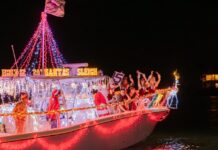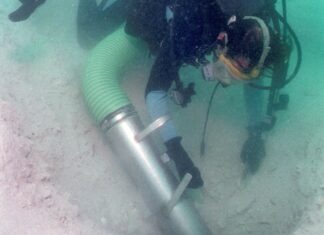Andreas Franke, a Keys-based photographer, has been creating exhibits that also raise environmental awareness. Most recently, his “Plastic Ocean” has garnered attention for its unblinking look at waste in our oceans and on shorelines. Franke came to the Keys 30 years ago and began diving, notably the shipwrecked Vandenburg. The Vandenberg boasts a 500-plus foot artificial reef, the second largest in the world, home to a diverse ecosystem of marine life.
Franke has done shipwreck dives around the world, from Key West to Croatia. He tells the origin story of his idea for his unconventional photo exhibit, “The Sinking World:” “I was diving in Egypt, and I was there, on an old dive boat, and there was a magazine about the sinking of the Vandenberg.” The serendipitous experience brought Franke back to the Keys, where he pursued a vision of not only photographing the ship, but also displaying the images on the ship, in the first-ever underwater exhibit on a shipwreck. His mission to get permission for the exhibit — which took many months, emails, and heavy-duty magnets — led him to Joe Wetherby, the man behind the sinking of the Vandenberg.
Wetherby helped him see a new perspective of the shipwreck. “For me as an artist,” he said, “it starts with thinking about why do we do this: sink ships and bring them to a place in the ocean where normally they should not be?
“But when you come down, you see thousands and thousands of fish, and normally there would only be sand down there,” he said. “It’s amazing. It’s a big home for all of them.” Franke affixed his photographs to the ship with 200-pound magnets for divers to view. After several months, the byproduct was the growth of oceanic micro-organisms over the photographs, which yielded art that was part human creation, part environmental.
Franke played with the juxtaposition of humanity and technology in nature in “The Sinking World.” In “Plastic Ocean,” he puts beautiful models in water amid garbage—in this case, loads of plastic he and his team collected along an Italian shoreline.
“It took four people one hour to fill 10 huge bags—and we could have done it in 30 minutes,” he said.
One thing that struck Franke was the inevitability of micro-plastics. “You think things are stable,” he said, “and you pick them up, and they break into small pieces. … The world is so unbelievably full of plastic, and it’s been in a really short time. Mankind did not think, we just produced.”
This destruction inspired Franke, and he believes that images can create an impression that words may not. “Fish eat it, the turtles do, the whales do,” he said. “But it’s not just them: we kill ourselves, too.”
Franke is planning a new photography project for the Keys to debut this spring or summer. He said it will be “even stronger” than Plastic Ocean, in hopes that his photography can serve to spark activism and awareness. “I feel that art can open you up. … If you see something beautifully done, your brain opens more and more.”
Perhaps if people are not listening to the message of plastic harming our oceans, artists like Franke can help them see it.























